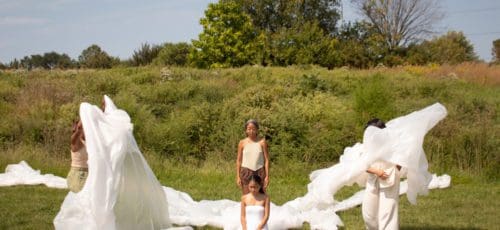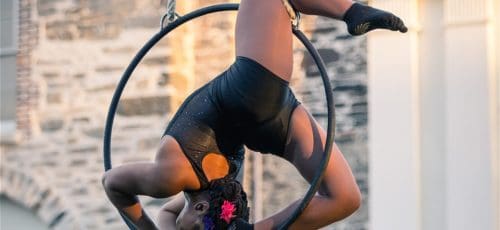Dancing through Diasporas: Interview with Shaily Dadiala of Usiloquy Dance Designs
“Moving to the United States changed everything.”
Shaily Dadiala, artistic director of Usiloquy Dance Designs, has been dancing Bharatanatyam, a classical Indian dance form, since childhood. After growing up in Bardoli, a city in Gujarat, India, Shaily moved to the United States, where she formed her own ensemble. Usiloquy presents innovative, cross-cultural Bharatanatyam dances informed by stories of immigration and multiculturalism. On Saturday, July 26th, Usiloquy Dance Designs performs an original dance, Ragas and Airs, combining Bharatanatyam dance and Celtic music. We caught up with Shaily to find out more about her life as a dancer
FringeArts: What kind of dance did you do growing up?
Shaily Dadiala: At age four, I was part of a kindergarten dance group in India. I distinctly remember rehearsals, shopping for jewelry with my mother, and dancing at the annual gathering on stage. It was a “welcome dance” inaugurating the event.
I started learning Bharatanatyam at age nine. You had to be sixteen years old in order to take the state board exam at the end of the seven-year course’s graduation. Before the formal training, I would excitedly throw my arms and legs around in make-believe dance concerts.
FringeArts: How did you decide to specialize in Bharatanatyam?
Shaily Dadiala: I owe genuine gratitude to my parents for that. They recognized the dance itch in me as something that wouldn’t go away, something that needed formal nurture. My home town at that time offered structured training only in Bharatanatyam. My parents enrolled me, and I was entranced from day one. The style feels encoded, almost epigenetically, and it has never been a matter of choosing it over another.
FringeArts: Did moving to the United States change your relationship to dance?
Shaily Dadiala: Moving to the United States changed everything. Until then, Bharatanatyam was something I simply enjoyed. The experience of being an immigrant here—the pressure to assimilate, the desire to belong, the stereotyping—has deeply informed my dance discipline over the years. My dance practice has represented how I myself have navigated the tensions of creating a home here in the United States while I remain true to the classical grammar of Bharatanatyam movement. My inspiration comes from preserved music styles, folklore, and cultural practices of the myriad diasporas I see around me, and I see my journey reflected in theirs.
FringeArts: How did you decide to form Usiloquy Dance Designs?
Shaily Dadiala: I wanted to project my work through the texture and complexity that only an ensemble can bring to the stage. I quit my full-time job and established Usiloquy in 2008. Students had been taking classes with me since 2006, some of whom I invited to join the company. “Soliloquy” was my favorite Shakespeare word. Replacing “Sol” with “Us” to make “Usiloquy”—our conversations—seemed like a pretty neat neologism to me. Besides, Bharatanatyam was the only element that I could coherently tie to the narrative of my birth country.
FringeArts: What is it like to teach an Indian dance form in the United States?
Shaily Dadiala: It is mostly fun and interesting. I think the average dance student and aspirant dancer is hard working and eager to learn. Sure, there is plenty of background knowledge like the history of the dance, symbols from ancient scriptures, and cultural jargon that I cannot take for granted. Teaching non-South Asian students has become a refining mechanism for my historical knowledge! There is a healthy curiosity and yearning for training across all age groups and institutions, which is highly encouraging. There are some weird instances though, when Bharatanatyam is confused with Bollywood dance or belly dance.
FringeArts: How do you use the meeting of cultures to create work?
Shaily Dadiala: Music is the trigger, usually. If I hear certain music and it intrigues me enough, I start digging deeper into the culture at large. We all are immigrants, give or take a few years or a few centuries. Immigration creates diasporas, which, curiously enough, preserve old music and cultures more judiciously than their originating sources. As a choreographer, I seek points of intersection between my immigrant identity and adaptation of my classical dance training. I create works drawing upon the fundamental vocabulary of rhythmic footwork, hand gestures, and mime inherent to Bharatanatyam, juxtaposed with music and narrative devices not traditional to South Indian arts.
FringeArts: What is your motivation to keep dancing?
Shaily Dadiala: The delicious dichotomy of complete freedom and rigorous discipline. I was raised Hindu and Sikh in Gujarat, India, where I earned my degree in Bharatanatyam before making the United States my permanent home in 2000. I am a survivor of domestic violence who feels a sense of belonging in all cultures I encounter; equally impassioned by the individual’s right to liberty as by a community’s power in sustaining tradition. My trajectory as a perpetual immigrant strongly influences my artistic ethic—treating diasporas, sub-cultures, and immigrant practices as sources of disalienation. It is thrilling and humbling to see how diverse small communities thrive around the world. Translating their stories through Bharatanatyam is my motivation.
FringeArts: What’s next for Usiloquy Dance Designs?
Shaily Dadiala: We are working on our original production Ragas and Airs, based on Celtic music and commonalities between South Asian and Celtic culture. On Saturday, July 26th, we are performing excerpts from the work at The Irish Memorial, with a bronze sculpture as a backdrop. As an organization, we are constantly learning and growing and looking forward to new partnerships.
Thank you, Shaily!
Usiloquy Dance Design’s free performance of Ragas and Airs will include an interactive demonstration. More information can be found online: usiloquydance.org/opus
Ragas and Airs
Saturday, July 26th at 4pm + 7pm
The Irish Memorial
100 S Front St (at Front and Chestnut)
Free
—Miriam Hwang-Carlos




